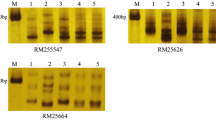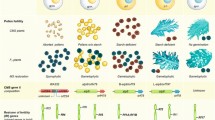Abstract
In response to the challenge of food security in the new century, heterosis exploitation is being intensified as an effective way to increase grain yield of rice. Thus, breeding of new cytoplasmic male sterility (CMS) is necessary so as to prevent homogenization of hybrid rice in commercial breeding programs. As the rapid development of molecular biology, molecular marker based selection can not only increase the efficiency and accuracy for breeding, but also provide us the possibility to create new CMS by genotypic identification. In this study, we developed a novel CMS rice by screening rice male sterility-inducing cytoplasm and maintainer candidates using mitotype-specific and nuclear molecular markers, respectively. Field trials reveal that the newly bred CMS line has good general combining ability and special combining ability for generation of hybrid rice, which means that the molecular marker system provides us an efficient and practicable approach for development of new CMS in rice breeding programs.



Similar content being viewed by others
References
Ahmadikhah A, Karlov GI (2006) Molecular mapping of the fertility-restoration gene Rf4 for WA-cytoplasmic male sterility in rice. Plant Breed 125:363–367
Cheng SH, Zhuang JY, Fan YY, Du JH, Cao LY (2007) Progress in research and development on hybrid rice: a super-domesticate in China. Ann Bot 100:959–966
Fujii S, Toriyama K (2009) Suppressed expression of retrograde-regulated male sterility restores pollen fertility in cytoplasmic male sterile rice plants. Proc Natl Acad Sci USA 106:9513–9518
Fujii S, Kazama T, Yamada M, Toriyama K (2010) Discovery of global genomic re-organization based on comparison of two newly sequenced rice mitochondrial genomes with cytoplasmic male sterility-related genes. BMC Genom 11:209
Griffing B (1956) Concept of general and specific combining ability in relation to diallel crossing systems. Aust J Biol Sci 9:463–493
Li S, Yang D, Zhu Y (2007) Characterization and use of male sterility in hybrid rice breeding. J Integr Plant Biol 49:791–804
Li S, Xie H, Qian M, Chen G, Li S, Zhu Y (2012) A set of SCAR markers efficiently differentiating hybrid rice. Rice Sci 19:14–20
Luan J, Liu T, Luo W, Liu W, Peng M, Li W, Dai X, Liang M, Chen L (2013) Mitochondrial DNA genetic polymorphism in thirteen rice cytoplasmic male sterile lines. Plant Cell Rep 32:545–554
Luo D, Xu H, Liu Z, Guo J, Li H, Chen L, Fang C, Zhang Q, Bai M, Yao N, Wu H, Ji C, Zheng H, Chen Y, Ye S, Li X, Zhao X, Li R, Liu YG (2013) A detrimental mitochondrial-nuclear interaction causes cytoplasmic male sterility in rice. Nat Genet 45:573–577
Majid S, Arumugam K, Glenn BG, Sant SV (2008) Comparative genetic analysis and molecular mapping of fertility restoration genes for WA, Dissi, and Gambiaca cytoplasmic male sterility systems in rice. Euphytica 160:305–315
Makumbi D, Betrán J, Bänziger M, Ribaut J (2011) Combining ability, heterosis and genetic diversity in tropical maize (Zea mays L.) under stress and non-stress conditions. Euphytica 180:143–162
Marilia C, Servio T, Valter O, Clibas V, Sui T (2001) Combining ability for nodulation in common bean (Phaseolus vulgaris L.) genotypes from Andean and Middle American gene pools. Euphytica 118:265–270
Murray MG, Thompson WF (1980) Rapid isolation of high molecular weight plant DNA. Nucleic Acids Res 8:4321–4325
Ngangkham U, Parida SK, De S, Anand Raj Kumar K, Singh AK, Singh NK, Mohapatra T (2010) Genic markers for wild abortive (WA) cytoplasm based male sterility and its fertility restoration in rice. Mol Breed 26:275–292
Qu Z, Li L, Luo J, Wang P, Yu S, Mou T, Zheng X, Hu Z (2012) QTL mapping of combining ability and heterosis of agronomic traits in rice backcross recombinant inbred lines and hybrid crosses. PLoS ONE 7:e28463
Rajendran N, Gandhimani R, Singh S, Palchamy K (2007) Development of a DNA marker for distinguishing CMS lines from fertile lines in rice (Oryza sativa L.). Euphytica 156:129–139
Rao Y, Li Y, Qian Q (2014) Recent progress on molecular breeding of rice in China. Plant Cell Rep 33:551–564
Rohlf F (1992) NTSYS-pc: numerical taxonomy and multivariate analysis system, version 1.8. Exter Software, New York
Shinjyo C (1969) Cytoplasmic-genetic male sterility in cultivated rice, Oryza sativa L. II: the inheritance of male sterility. Jpn J Genet 44:149–156
Song G, Guo Z, Liu Z, Qu X, Jiang D, Wang W, Zhu Y, Yang D (2014) The phenotypic predisposition of the parent in F1 hybrid is correlated with transcriptome preference of the positive general combining ability parent. BMC Genom 15:297
Tan Y, Xie H, Li N, Li S, Zhu Y (2012) Molecular characterization of latent fertility restorer loci for Honglian cytoplasmic male sterility in Oryza species. Mol Breed 30:1699–1706
Tang H, Luo D, Zhou D, Zhang Q, Tian D, Zheng X, Chen L, Liu YG (2014) The rice restorer Rf4 for Wild-abortive cytoplasmic male sterility encodes a PPR protein that functions in reduction of WA352 transcripts. Mol Plant 7:1497–1500
Wang K, Peng X, Ji Y, Yang P, Zhu Y, Li S (2013) Gene, protein, and network of male sterility in rice. Front Plant Sci 4:92
Wise RP, Pring DR (2002) Nuclear-mediated mitochondrial gene regulation and male fertility in higher plants: light at the end of the tunnel? Proc Natl Acad Sci USA 99:10240–10242
Xie H, Wang J, Qian M, Li N, Zhu Y, Li S (2014) Mitotype-specific sequences related to cytoplasmic male sterility in Oryza species. Mol Breed 33:803–811
Xu Y, Lu Y, Xie C, Gao S, Wan J, Prasanna BM (2012) Whole-genome strategies for marker-assisted plant breeding. Mol Breed 29:833–854
Yuan L, Peng J (2005) Hybrid rice and world food security. China Science and Technology Press, Beijing
Acknowledgments
This research was partly supported by the 863 program (2014AA10A604-9) and the National Transgenic Research and Development Program (2011ZX08001-004) of China.
Author information
Authors and Affiliations
Corresponding authors
Electronic supplementary material
Below is the link to the electronic supplementary material.
Rights and permissions
About this article
Cite this article
Fan, F., Li, N., Wang, J. et al. Molecular marker-directed development of a novel cytoplasmic male sterile line in rice. Mol Breeding 35, 212 (2015). https://doi.org/10.1007/s11032-015-0394-2
Received:
Accepted:
Published:
DOI: https://doi.org/10.1007/s11032-015-0394-2




